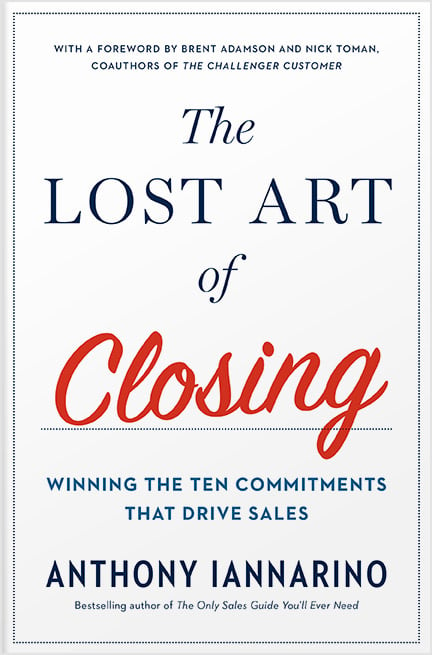The Gist:
- Sometimes what you do—or fail to do—comes with immediate negative consequences.
- Other times, it takes a while to see the negative consequences, causing you to miss the connection.
- The key to avoiding serious mistakes and negative outcomes is to recognize their causes.
Some sales-related actions you take immediately provide you with negative consequences, letting you know that you have made a mistake. But there are other actions you take—or fail to take—whose consequences are felt much later.
While the following list is in no way exhaustive, it gives you an idea of the kind of seemingly innocuous decisions that will dole out a hailstorm of negative consequences in the future.


Too Little Prospecting
One of the most damaging decisions a salesperson might make is to postpone the prospecting that they need to do today, burning in a pattern that will certainly harm them in the future. You will suffer no negative consequences today for failing to create new opportunities—one of only two sales actions that produce results. In fact, were you to make zero calls over the course of a week, there would be no immediate negative repercussions that whole week.
The prospecting you do today is what results in a won deal ninety days from now, or however long your typical sales cycle lasts. The negative consequence of not prospecting today is a poor result in the future, normally manifesting as missing your goals, a loss of commission, and a conversation with your manager about your poor habits.
Failing to Gain the Next Commitment
You had a terrific meeting with your prospective client. It was clear to both of you that they have the exact challenge that you are able to solve. Even better, you know that your solution is absolutely perfect for the prospective client, and you are certain that your client is going to be blown away by the results. But when your main contact said, “We very much enjoyed meeting you and we’ll follow up with you next week,” you simply smiled, agreed, and shook hands.
Now it’s been three weeks, and you are inches away from being a legitimate stalker: calling the contact’s phone and hanging up, sending them emails that read like something written by a jilted lover, and leaving voicemails that make you look even more desperate than you are. It sounded so simple to let them make the next move, but now you’re wasting your time chasing them because you didn’t secure the next meeting before you left your client’s office.


Sending Proposals and Pricing by Email
Your client told you that they are going to make a fast decision, and unfortunately, they don’t have time for an additional meeting. They asked you if you would be able to send them a proposal and price list so they can review it. You believed they would appreciate your being helpful, compliant, and obedient to their wishes, so you clicked send and once again ceded control of the process to the client. Apparently, it takes you a while to learn that you are better off dealing with problems now by doing what is necessary to avoid bad future outcomes.
Your client did look at your pricing, alongside the 149 other emails they had to process. But then they sat down to meet with your competitor, the one who strongly recommended they take more time to make sure their solution was exactly right. Weeks after they made a decision, the client informed you that they “decided to go a different direction.”
Believing Your Client Isn’t Going to Replace You
The letter you received explains that one of your largest clients is ending your contract at the end of the year, and that they are going to begin the transition in the coming weeks. You’ve been complacent, negligent, and a little bit entitled, believing that their recent challenges were just a rough spot, like the many you have helped them work through over the many years you’ve served them.
Because you didn’t do the work to proactively solve the client’s problems, they decided that you didn’t believe they were important enough to deserve your help with the very same set of problems your most aggressive competitor is now solving for them. The negative consequences lagged behind your apathy by some number of months, time that you should have used solving the problem that ultimately let a competitor eat your lunch.
Taking Bad Clients
When you sat down across from the gruff, frank contact at what was then a prospective client, you smiled when you heard him tell you all the ways that your competitor was failing them. Then he told you how terrible all their other partners were, too, seemingly all the way back to the company’s founding. Just when you were starting to worry, he said that you and your company were a much better fit and that he was certain you’ll do better work.
You assumed that the client was compelled to change, so you didn’t explore the client’s expectations and deepen your mutual understanding about exactly how and why they failed. Now you’ve unleashed a nightmare client, one that burns with the power of a thousand Karens, on the rest of your company. Sure, you won the deal, but now you are listening to daily complaints from a client whose expectations are out of line with reality.
Creating Too Little Value in the Sales Conversation
You provided your client with information about your company and your solutions. You asked the contacts all the usual questions, and of course you told them at least three times why your company is the best in the business. In doing so, you treated what your client saw as a strategic and important decision as if it were nothing more than a transaction, creating no value for them as it pertains to their future results and how best to achieve them.
You lost that deal in the discovery process, but because your client didn’t bother to tell you that they bought from someone else, you continue creating too little value for your other contacts, repeating a pattern of losses and disappointments without understanding why the negative consequences continually rain down on you.


Misunderstanding Dogs
New dog owners often make the mistake of punishing their pet for a mistake hours after it happened, especially when it damages their carpet. Even that short time lag leaves the dog confused, as it is not capable of connecting the two events.
Be smarter than the average Golden Retriever: if a negative pattern repeats itself, save yourself another round of trouble by recognizing what caused the negative consequences, even if they show up weeks or months later.
Do Good Work:
- Whenever you experience negative consequences, explore what caused them, looking as far back as you can to understand.
- Having made the connections, decide what actions you might take (or avoid) to prevent similar results in the future.
- Be proactive in any scenario where there is potential for negative consequences, by acting decisively to avoid them.

Essential Reading!
Get my 2nd book: The Lost Art of Closing
"In The Lost Art of Closing, Anthony proves that the final commitment can actually be one of the easiest parts of the sales process—if you’ve set it up properly with other commitments that have to happen long before the close. The key is to lead customers through a series of necessary steps designed to prevent a purchase stall."
Buy Now







.jpg?width=768&height=994&name=salescall-planner-ebook-v3-1-cover%20(1).jpg)


